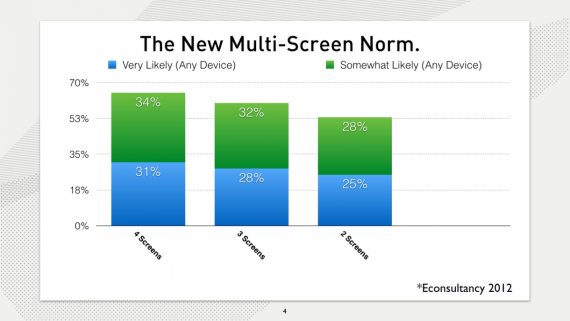Foresights and ideas that expand minds and inspire a change of heart.

There's been no shortage of recent research documenting the rise of the multi-channel consumer, especially with the ever increasing proliferation of all things digital.

The rise of mobile, continued growth in internet penetration and traffic, booming smartphone and tablet sales, social media usage and channel growth, the decline of many bricks and mortar outlets and the digital replication of traditional physical mediums/ activities (for a comprehensive guide on the latest digitalisation trends check out Anders Sorman-Nilsson's Digilogue presentation, or The Future of Digital presentation by Business Insider.
Here are some statistics on just how well connected Americans are:
More channels has led to greater complexity as consumers are increasingly defining their own purchase process including what touch-points to use, how to use them, and when to use them. This channel complexity from beginning to end, presents a contant risk for companies as they face the threat of a loss of customers to a competitor that has better optimised a particular touch-point, or better optimised the experience across a range of different touch-points, providing a better unified and seamless experience.
Not only are customers accessing a wider range of channel touch-points or using a combination of physical and digital channels simultaneously (for example, customers choosing to purchase a good through mobile, either through the company's mobile website or a retailer like Amazon, while examining the physical good in a retail outlet), companies are seeing the growing trend of 'technophiles' using multiple screens to simultaneously interact with a company (for example, TV + tablet + mobile + PC), in effect shortening the overall purchase process.
New research by Google Think Insights sheds new insight into how exactly consumers are interacting with companies across a range of screens simultaneously.

Companies must not only take into account the growing number of customers switching between devices sequentially on their path to purchase, but also cater to customers who prefer to transact simultaneously across devices. This means using one device as a method to trigger specific behaviour on another such as having different forms of content tailored to each device, allowing customers to transition easily between devices or promoting customers to switch between devices through rewards and incentives. Simultaneity drives engagement - as long as companies treat each channel as a stand alone experience catering to a specific subset of customers or as the same experience simply replicated over and over again across devices, there remains an untapped opportunity to drive engagement through promoting cross-device usage.

Header Text
Lorem ipsum dolor sit amet, consectetur adipiscing elit, sed do eiusmod tempor incididunt ut labore et dolore magna aliqua. Ut enim ad minim veniam, quis nostrud exercitation ullamco laboris nisi ut aliquip ex ea commodo consequat. Duis aute irure dolor in reprehenderit in voluptate velit esse cillum dolore eu fugiat nulla pariatur.
Lorem ipsum dolor sit amet, consectetur adipiscing elit, sed do eiusmod tempor incididunt ut labore et dolore magna aliqua. Ut enim ad minim veniam, quis nostrud exercitation ullamco laboris nisi ut aliquip ex ea commodo consequat. Duis aute irure dolor in reprehenderit in voluptate velit esse cillum dolore eu fugiat nulla pariatur.
Lorem ipsum dolor sit amet, consectetur adipiscing elit, sed do eiusmod tempor incididunt ut labore et dolore magna aliqua. Ut enim ad minim veniam, quis nostrud exercitation ullamco laboris nisi ut aliquip ex ea commodo consequat. Duis aute irure dolor in reprehenderit in voluptate velit esse cillum dolore eu fugiat nulla pariatur.

Header Text
Lorem ipsum dolor sit amet, consectetur adipiscing elit, sed do eiusmod tempor incididunt ut labore et dolore magna aliqua. Ut enim ad minim veniam, quis nostrud exercitation ullamco laboris nisi ut aliquip ex ea commodo consequat. Duis aute irure dolor in reprehenderit in voluptate velit esse cillum dolore eu fugiat nulla pariatur.
Lorem ipsum dolor sit amet, consectetur adipiscing elit, sed do eiusmod tempor incididunt ut labore et dolore magna aliqua. Ut enim ad minim veniam, quis nostrud exercitation ullamco laboris nisi ut aliquip ex ea commodo consequat. Duis aute irure dolor in reprehenderit in voluptate velit esse cillum dolore eu fugiat nulla pariatur.
Lorem ipsum dolor sit amet, consectetur adipiscing elit, sed do eiusmod tempor incididunt ut labore et dolore magna aliqua. Ut enim ad minim veniam, quis nostrud exercitation ullamco laboris nisi ut aliquip ex ea commodo consequat. Duis aute irure dolor in reprehenderit in voluptate velit esse cillum dolore eu fugiat nulla pariatur.

Header Text
Lorem ipsum dolor sit amet, consectetur adipiscing elit, sed do eiusmod tempor incididunt ut labore et dolore magna aliqua. Ut enim ad minim veniam, quis nostrud exercitation ullamco laboris nisi ut aliquip ex ea commodo consequat. Duis aute irure dolor in reprehenderit in voluptate velit esse cillum dolore eu fugiat nulla pariatur.
Lorem ipsum dolor sit amet, consectetur adipiscing elit, sed do eiusmod tempor incididunt ut labore et dolore magna aliqua. Ut enim ad minim veniam, quis nostrud exercitation ullamco laboris nisi ut aliquip ex ea commodo consequat. Duis aute irure dolor in reprehenderit in voluptate velit esse cillum dolore eu fugiat nulla pariatur.
Lorem ipsum dolor sit amet, consectetur adipiscing elit, sed do eiusmod tempor incididunt ut labore et dolore magna aliqua. Ut enim ad minim veniam, quis nostrud exercitation ullamco laboris nisi ut aliquip ex ea commodo consequat. Duis aute irure dolor in reprehenderit in voluptate velit esse cillum dolore eu fugiat nulla pariatur.
& STAY UP TO DATE WITH FORESIGHTS AND TREND REPORTS!
WE WILL EQUIP YOU WITH THE VIDEOS AND MATERIALS YOU NEED TO SUCCESSFULLY PITCH ASN.
0 Comment